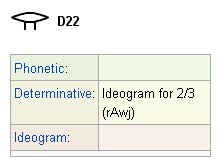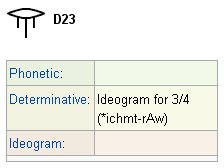4. In the solar
zodiac there is a
mata in front only at the beginning
of the 'Sea' (Capricorn), and we
remember what happened to
Rigi. His name could allude
to Ragi because he raised the upper half-shell
(«) a
little, and at that time his
salty sweat became
the 'Sea' (3). Later he died from
his efforts at raising Sky much
higher, and Old-Spider could
then finish her work by creating Sun
(5) - before Earth (4):
...
Old-Spider then took the
snail, placed it in the west
of the shell, and made it
into the moon. Then there
was a little light, which
allowed Old-Spider to see a
big worm. At her request he
opened the shell a little
wider, and from the body of
the worm flowed a salted
sweat which collected in the
lower half-shell and became
the sea. Then he raised the
upper half-shell very high,
and it became the sky.
Rigi, the worm,
exhausted by this great
effort, then died.
Old-Spider then made the sun
from the second snail, and
placed it beside the lower
half-shell, which became the
earth ...
The central
vertical line in hau tea is
normally not stretching all the
way up to the 'roof':
|
6.
The imaginary
central vertical
line in hau
tea does
correspond to an
imaginary
line
on Easter
Island. As has
been suggested
the vertical
line at right in
the glyph
probably
represents the
horizon in the
east and the
vertical line at
left the horizon
in the west,
while the
central one
cannot be a
horizon - there
is no more
parallel
horizon:

Instead the
central line is
imaginary -
shown by it
being a separate
element not
connected with
the rest of the
glyph.
The center of
the island is
Anakena with
the king. As
noted in Barthel
2, also
Vinapu is
located in the
middle, and an
imaginary line
can be drawn
between these
two central
places:
'... On the
'second list of
place names',
Hanga Te Pau
is called 'the
middle (zenith)
of the land' (he
tini o te kainga).
This may refer
to a line
bisecting the
island...
Vinapu and
Anakena
were calendary
opposites ...'
Astronomers
observe stars
rising in the
east and setting
in the west, but
they also
observe them
when they are
passing right
overhead. A kind
of structure
with 3 parallel
lines is used
for observing
stars.
Hamlet's Mill:
'It should be
stated right now
that 'fire'
is actually a
great circle
reaching from
the North Pole
of the celestial
sphere to its
South Pole ...'
At noon sun
stands high and
blazing, and the
great 'fire'
circle noted in
Hamlet's Mill
presumably is
equal to the
imaginary line
through
Anakena
southwards to
Vinapu. Sun
moves from east
to west, but the
imaginary line
is oriented the
other way, from
north to south,
and therefore it
is a line
marking time and
a line connected
with the moon.
The name hau
tea is quite
in order, it is
primarily a
female glyph
type, a glyph
type for
housing new life. |
|
'The
traditions
show that
the
residences
of the king
were fairly
flexible.
The building
of new
houses was
obviously
the result
of (male)
births in
the royal
family. In
each case,
the house
that was
built last
is left to
the newborn
son and his
mother,
together
with a
specific
servant,
while the
king has a
new and
separate
residence
constructed
for himself.
Ms. E
clearly
demonstrates
this
procedure,
which was
followed in
spite of
Hotu Matua's
quarrel with
Vakai.
In the text
four houses
are
associated
with the
four sons.
Later
residences
of Hotu
Matua
have
different
names and
are the
scenes of
different
activities.
The four
sons and the
four houses
are
coordinated
as shown in
Table 10:
|
TABLE 10 |
| 1. Hare Tupa Tuu |
1. Tuu Maheke |
| 2. Hare Pu Rangi |
2. Miru (Te Mata Nui) |
| 3. Hare Moa Viviri |
3. Tuu A Hotu Iti (Te Mata Iti) |
| 4. Hare Moa Tataka |
4. Tuu Rano Kau |
The first
house is
located in
Oromanga.
It is the
residence (maara
noho) of
the
immigrant
king that
was
envisioned
in the dream
voyage and
sought by
the
explorers.
The second
and the
third houses
are also
said to have
been in
Anakena,
a short
distance
away ('60
meters',
according to
my
informant).
Supposedly,
the same is
true of the
fourth
house. It is
difficult to
translate
the names of
the houses.
Below is an
incomplete
list of
possible
translations:
| tupa tuu |
'the crab has arrived'; 'the litter has arrived'; 'a stone tower has been erected' |
| pu rangi |
'the shell trumpet calls'; 'hole in the sky'; 'royal tribe' |
| moa viviri |
'rooster who turns around'; 'energetic son' |
| moa tataka |
'the roosters form a circle'; 'son who departs' (? RAR.)' or 'son who doesn't fulfill the expectations (? MAO.)'; 'son who unites many around himself' |
It appears
that the
names of the
houses of
the four
sons are
arranged in
pairs and
express some
characteristics
of the
descendents
who live in
them. Only
Ms. E shows
this type of
connection.
Arturo Teao
mentions
some of the
names of the
houses, but
he does not
associate
them with
the
respective
sons.
According to
him, 'Hare
Tupa Tuu'
is the first
residence of
the king
after the
immigration
(TP:44).
After the
quarrel with
Vakai,
Hotu
Matua
moves to 'Hare
Moa Viviri'
and later to
'Hare
Moa
Tataka'.
The second
and the
third
residences
are
associated
with
successful
agricultural
activities
(TP:51).
Then this
source
deviates
from Ms. E:
the fourth
residence is
'Te Ngao
O Te Honu',
and the
island king
is
accompanied
to this
place by a
small
adopted boy.
The fifth
residence is
'Taro
Tataka'.
In each
case, the
king is
followed by
Vakai.
According to
Leonardo
Pakarati,
'the neck of
the turtle'
was the
birthplace
of the
youngest
son, Tuu
Hotu
Iti. He
has no
information
about the
place called
'taro is
standing in
a circle'.
Ms. E lists
as the last
residences 'Aro
Huri'
(for three
months), 'Maunga
Pua'
(for three
months), and
'Tavarivari
A Umi'.
As already
mentioned, 'Aro
Huri'
is a slight
elevation in
the flank of
Maunga
Koua,
and it is
the fourth
point of
demarcation
along the
border of
the tabooed
royal
district.
'Maunga
Pua'
is the old
name for the
mountain now
called 'Maunga
Koua'.
It is the
fifth point
of
demarcation
along the
border of
the royal
precinct.
The last
name could
not be
located."
(Barthel 2) |
The
'zenith' line must
be there in order to
serve as a line of
measurement, where
in the middle of the
night the stars are
culminating.
Furthermore, number
3 seems to
characterize the
'Sea of Night',
because in the Moon
perspective there
are 13 synodic months in a
solar year and Sun
should have 10
of them:
...
Mgv.: rogouru,
ten. Mq.:
onohuu,
okohuu, id.
...
In
the centre of the
land (he tini o
te kaiga) is
Hanga Te Pau. It
is not at the centre
of the day (te
tini o te raŠ) -
that place comes
later:
|
Tini
To be at
the
zenith:
ku-tini-Š
te raŠ;
middle
of a
journey,
of a
period
of time;
te
tini o
te raŠ,
the
middle
of the
day.
Vanaga.
1. A
great
number,
innumerable,
infinite,
indefinite.
Tinitini,
million,
billion.
T Pau.:
tinitini,
innumerable.
Mgv.:
tini,
a
countless
number,
infinite.
Mq.:
tini,
id. Ta.:
tini,
numerous.
2.
Raa tini,
noon;
tini po,
midnight;
te
tini te
raa,
zenith;
topa
tini,
abortion.
Churchill. |
The
article of tini o
te kainga is not te
but he (cfr
at Kuhane).
One
of the Egyptian
hieroglyphs (D23 in
Gardiner's Sign
List) has 3
lines below:
Instead of a
'roof' (Ŕ) these 3 lines
have an
'opening' (mata)
above - the
time is 'te'
and not 'he'.
The single vertex
'roof' in
hau tea
can be
compared
with the
triplet of
vertexes in
mea ke
('a
different
kind of
mea'):
|







